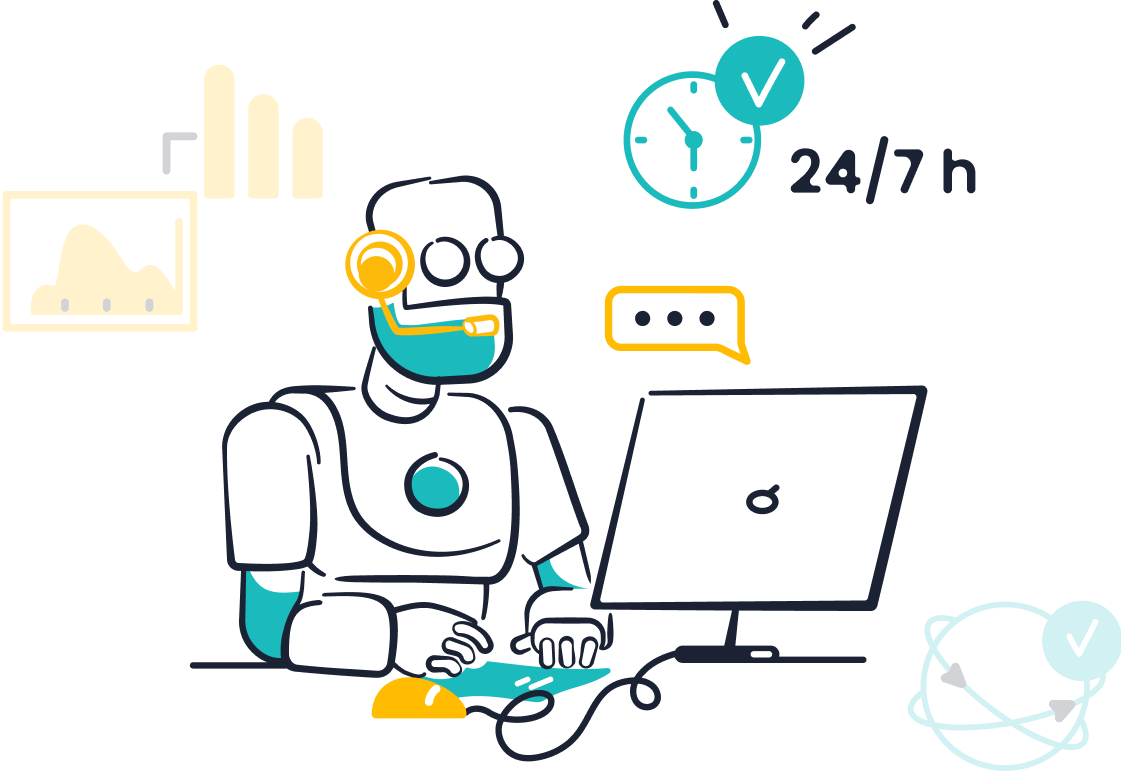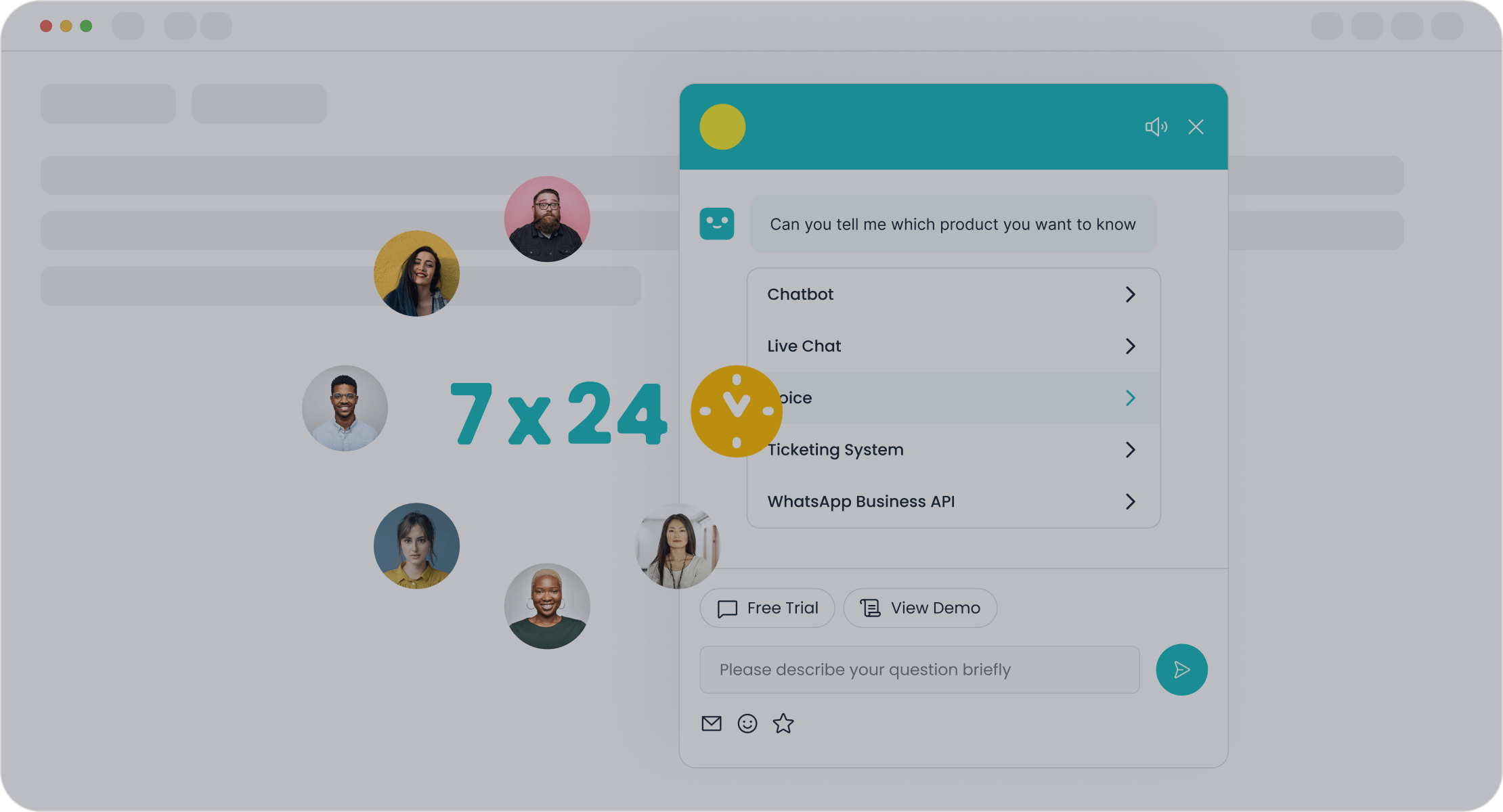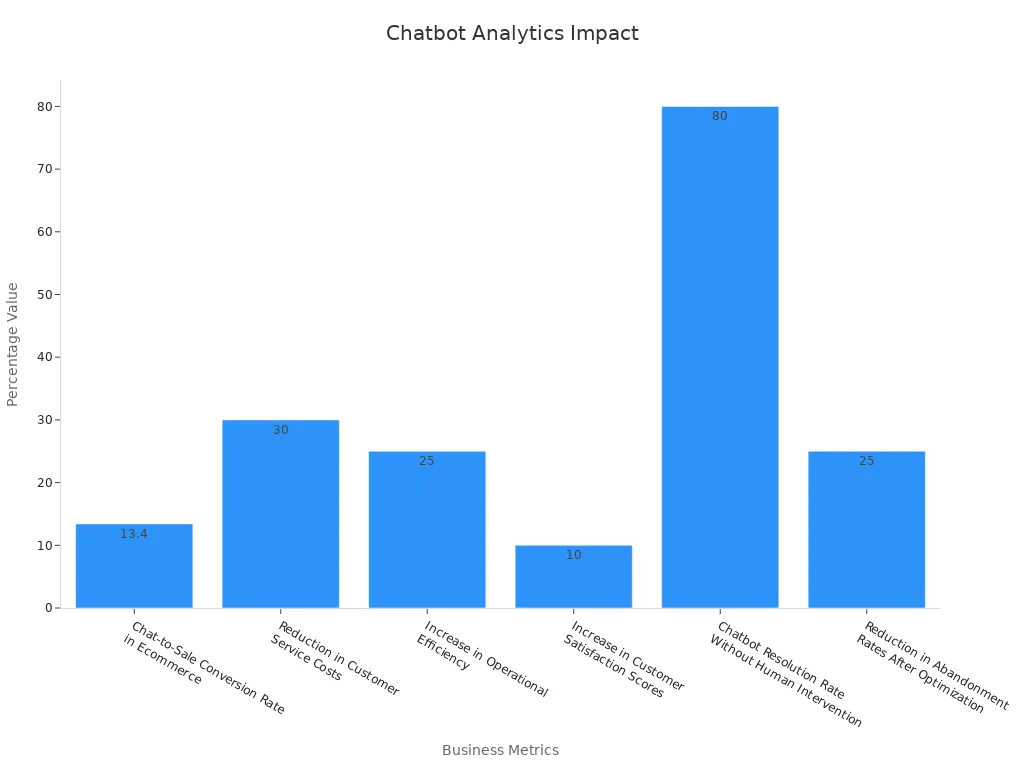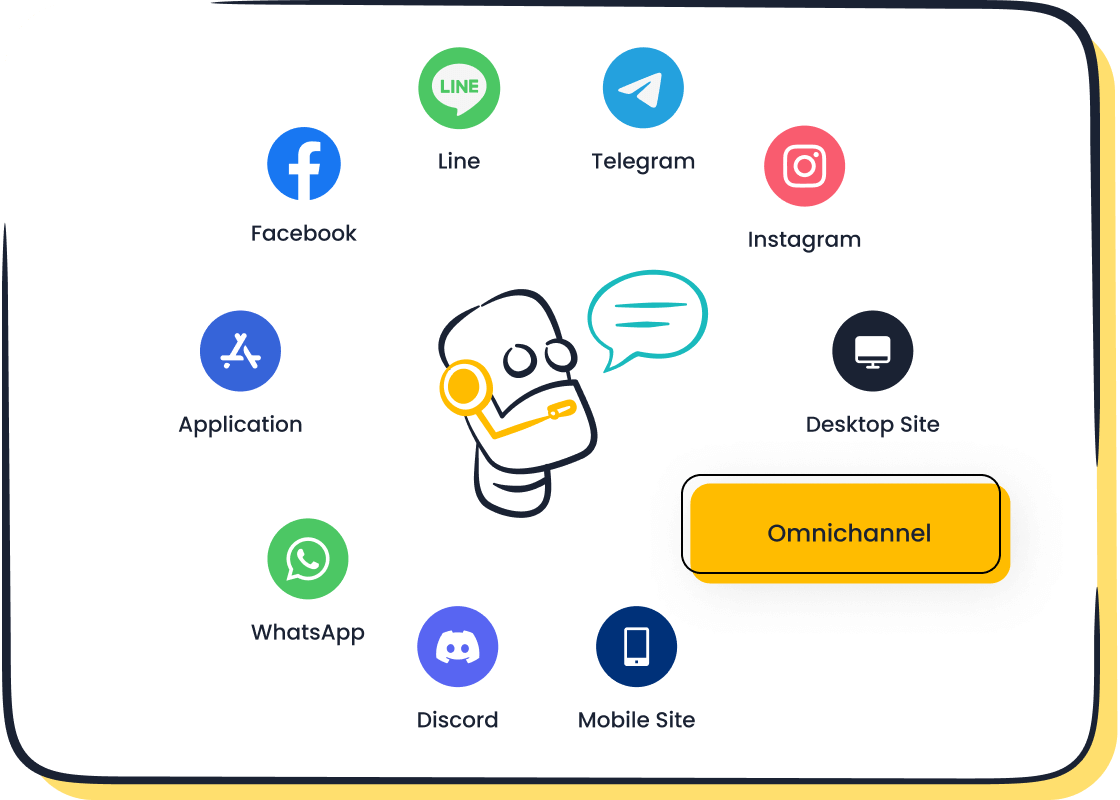Top Tips for Optimizing Chatbot Data Analytics Effectively

You need strong chatbot data analytics to keep your business customer-centric and competitive. Many companies see a boost in customer satisfaction when they use chatbot analytics to track and improve customer experience. Sobot AI helps brands like OPPO and Samsung handle millions of conversations every day. With Sobot, you can use analytics to understand what your customers want and measure business results. Data from chatbot analytics shows that real-time insights can help your business respond faster and personalize each interaction. Retail, ecommerce, and enterprise services all rely on analytics to improve customer experience and drive business growth.
Chatbot Data Analytics Metrics

Understanding the right metrics helps you get the most from chatbot analytics. Sobot’s reporting and analytics features let you track every important detail, so you can improve chatbot performance and boost customer satisfaction. You can use these insights to make better business decisions and deliver a stronger customer experience.
Performance Indicators
Performance metrics show how well your chatbot handles user interactions. You can measure the number of users, session length, retention rate, response time, completion rate, and error rate. These metrics help you spot both success rate and failure indicators. For example, a high completion rate means your chatbot resolves more requests, while a high error rate points to areas needing improvement.
| Metric | Description |
|---|---|
| Customer Satisfaction Score (CSAT) | Measures user satisfaction after chatbot interactions. |
| Retention Rate | Shows how many users return to use the chatbot again. |
| Conversion Rate | Tracks how well the chatbot drives actions like purchases or sign-ups. |
| Response Accuracy | Checks if the chatbot gives correct answers. |
| Escalation Rate | Counts how often the chatbot sends queries to human agents. |

Sobot’s analytics dashboard makes it easy to monitor these performance metrics in real time.
User Engagement
User engagement metrics tell you how users interact with your chatbot. You can track active users, total interactions, average conversation length, and interaction frequency. These chatbot analytics reveal how users move through the conversation flow and where they might drop off.
| Metric Name | Description | Benchmark |
|---|---|---|
| User Engagement Rate | Percentage of users who interact after the chatbot starts. | 35-40% |
| Total Interactions | Total number of chatbot interactions over a period. | N/A |
| Average Conversation Length | Average number of messages per conversation. | N/A |
| Interaction Frequency | How often users engage with the chatbot. | N/A |
Sobot’s omnichannel support lets you compare user engagement across channels like WhatsApp, SMS, and live chat.
Business Outcomes
Business outcome metrics show the impact of chatbot analytics on your goals. You can measure conversion rates, reduction in customer service costs, and increases in operational efficiency. For example, Sobot’s clients have seen up to a 30% reduction in service costs and a 25% increase in efficiency. High chatbot resolution rates also lead to better customer satisfaction and loyalty.
| Business Outcome Metric | Statistic | Source |
|---|---|---|
| Chat-to-Sale Conversion Rate in Ecommerce | 13.4% average | Zipchat AI |
| Reduction in Customer Service Costs | 30% | Juniper Research |
| Increase in Operational Efficiency | 25% | Juniper Research |
| Increase in Customer Satisfaction Scores | 10% within first year | Gartner |
| Chatbot Resolution Rate Without Human Intervention | 80% | ControlHippo |

Tracking these chatbot metrics with Sobot’s analytics tools helps your business improve customer experience, increase sales, and drive long-term growth.
Data Collection and Organization
Data Sources
You need strong data sources to get the most from chatbot analytics. Most analytics platforms, including Sobot, collect data from conversational logs, user interaction metrics, and direct user feedback. These sources help you track traffic volume, intent triggers, and user ratings. For example, Sobot’s omnichannel chatbot gathers analytics from WhatsApp, SMS, and live chat, giving you a complete view of customer interactions. Large Language Models (LLMs) can turn these conversations into actionable analytics, helping you spot trends and improve service. When you focus on defining clear objectives, you can choose the right data sources and ensure seamless integration with your analytics tools. This approach helps you capture both structured responses and free-text inputs, making your analytics more powerful.
Tip: Use conversation logs and user feedback together to get a full picture of your chatbot’s performance.
Structuring Data
Organizing your data well is key to effective analytics. Studies show that using knowledge graphs can boost query accuracy from 25% to over 92% (source). The table below shows some proven methods for structuring chatbot data:
| Methodology | Description | Impact on Analytics |
|---|---|---|
| Knowledge Graph (KG) | Connects data points with clear relationships | Query accuracy up to 92.5% |
| Virtual Knowledge Graph (VKG) | Builds graphs on demand for fast, scalable analytics | Faster data retrieval |
| LLM + KG Integration | Uses AI to turn questions into accurate data queries | Better natural language understanding |
| Retrieval-Augmented Generation (RAG) | Adds context to analytics using text embeddings | Limited for complex data |
Sobot’s analytics platform supports seamless integration with these advanced structuring methods, making it easier to organize and access your data. Defining clear objectives at this stage ensures your analytics stay focused and actionable.
Ensuring Quality
High-quality data leads to reliable analytics. Regular updates and validation improve chatbot accuracy and consistency. For example, one study found that median accuracy scores improved from 2.0 to 4.0 after refining chatbot algorithms. You should use key quality assurance metrics like response accuracy, intent detection, and context management. Sobot’s analytics dashboard helps you monitor these metrics in real time. A strong quality strategy includes:
- Functional testing for correct responses.
- Usability testing with user feedback.
- Performance testing under heavy loads.
- Security checks for data protection.
- Continuous improvement with regular updates.
Seamless integration of these steps ensures your analytics remain trustworthy and effective. Always focus on analytics that reflect real user preferences and support your business goals.
Analyzing Chatbot Data
Foundational Analytics
You can start with foundational analytics to measure chatbot performance and business impact. These analytics include metrics like user engagement, response time, and session length. Sobot’s chatbot analytics dashboard tracks these details in real time. You see how many users interact with your chatbot, how quickly it responds, and how often users return. This data helps you spot trends and make decisions that improve business results. For example, tracking response time ensures your chatbot keeps users interested and satisfied. Monitoring engagement rates shows you which conversation flows work best. These analytics form the base for deeper optimization.
Advanced Insights
Advanced analytics take your chatbot data analytics to the next level. You can use AI-powered tools like natural language processing (NLP), sentiment analysis, and clustering to uncover hidden patterns. Sobot’s analytics platform uses these methods to analyze chat transcripts and identify reasons for contact, friction points, and confusion triggers. For example:
- Sentiment analysis predicts customer satisfaction by studying chat language.
- Clustering groups conversations by topic, helping you see what issues matter most.
- Conversation intelligence filters chats by key events, so you understand not just what happens, but why.
These advanced analytics let you train your chatbot on frequent failure points, use successful agent replies to improve responses, and drive simple queries to automated channels. This approach boosts chatbot performance, increases first-contact resolution, and reduces customer effort. Industry data shows that these strategies lead to higher satisfaction and better business outcomes.
User Feedback Integration
User feedback is a powerful tool for chatbot analytics and business optimization. Sobot’s chatbot makes it easy to collect and analyze feedback from multiple channels. You can track user reviews, ratings, and direct comments. Analytics tools then cluster this feedback to find common themes and areas for improvement. For example:
- Tracking engagement and response time helps you refine conversation flows.
- Analyzing user reviews from app stores reveals what users like and dislike.
- Thematic analysis groups feedback into categories like usability, usefulness, and integration.
This process ensures your chatbot evolves based on real user needs. By integrating user feedback into your analytics, you support continuous improvement and deliver better business results.
Optimizing AI Chatbot Performance

NLP and Training Data
You can boost chatbot performance by focusing on NLP and quality training data. Start by defining clear business goals and measurable metrics like resolution rate and response time. Use real user queries, knowledge bases, and agent transcripts to train your chatbot. This approach improves the accuracy of AI responses and reduces bias. Research shows that enhancing NLP and training data can increase accuracy by up to 15.53% and improve F1-scores by +4.84 in low-data scenarios (source). Sobot’s AI chatbot uses advanced NLP models and continuous data updates to deliver effective chatbot conversations. Regularly update your training data and fine-tune models with domain-specific information. This process ensures your chatbot analytics reflect real-world needs and support ongoing optimization.
Tip: Regularly collect feedback and analyze unresolved queries to guide improvements in chatbot analytics and accuracy.
Personalization
Personalization makes chatbot interactions more engaging and effective. You can use strategies like proactive cart abandonment messages, multilingual support, and A/B testing of chatbot flows. For example, sending a message when a user abandons a cart can increase recovery rates and conversions. Multilingual chatbots raise customer satisfaction scores among non-native speakers. Sobot’s chatbot supports multiple languages and customizes responses based on user profiles, making customizing chatbots easy for your business. A/B testing helps you find the best tone, timing, and offers for your audience. Personalization also lets you calculate financial impact by comparing conversion rates between personalized and non-personalized flows. Continuous learning and model retraining keep your chatbot analytics up to date and support proactive personalized service.
- Proactive messages boost conversions.
- Multilingual support increases inclusivity.
- A/B testing improves goal completion rates.
Escalation Processes
A strong escalation process ensures effective chatbot conversations and high customer satisfaction. Set clear confidence thresholds and use sentiment analysis to decide when to transfer users to human agents. Key metrics include goal completion rate (aim for 90% or higher), deflection rate (60%-90%), and first contact resolution (at least 70%). Sobot’s chatbot pre-qualifies issues and passes full conversation context to agents, reducing customer frustration. Monitor response accuracy and response time to keep escalation rates low and maintain smooth chatbot analytics. Case studies show that seamless, context-rich handoffs improve CSAT scores and reduce the need for repeated escalations. Regularly review escalation data to optimize your process and support continuous improvement in chatbot performance.
| Metric | Target Value |
|---|---|
| Goal Completion Rate | ≥ 90% |
| Deflection Rate | 60%-90% |
| First Contact Resolution | ≥ 70% |
| Response Accuracy | > 90% |
| Response Time | < 2 seconds |
Reducing Friction
Reducing friction in chatbot interactions leads to more effective chatbot conversations and better user experience. You can achieve this by understanding customer needs, designing intuitive dialog flows, and continuously enhancing your data. Sobot’s chatbot uses analytics to identify friction points and optimize conversation flows. Personalization and contextual understanding help create tailored experiences, reducing user effort. Seamless integration with business systems allows chatbots to access relevant data and improve over time. Proactive assistance, such as anticipating questions, saves time and builds trust. Continuous learning and adaptability ensure your chatbot stays aligned with customer preferences and industry trends. These steps support improving chatbot performance and increase the accuracy of AI responses.
Note: Analyze chat transcripts and use conversation intelligence to spot and fix friction points quickly.
Chatbot Best Practices for Continuous Improvement
Continuous improvement is essential for keeping your chatbot effective and relevant. You can follow proven chatbot best practices to ensure your solution delivers value over time. Sobot’s approach includes regular updates, strong cross-team collaboration, and strict industry compliance. These strategies help you get the most from your chatbot analytics and drive ongoing chatbot improvement.
Monitoring and Testing
You should always monitor your chatbot’s performance using analytics tools. Regular monitoring helps you spot trends, measure user satisfaction, and catch issues early. Sobot’s analytics dashboard tracks key metrics like conversation volume, intent accuracy, fallback rate, and customer satisfaction scores. The table below shows important metrics to watch:
| Metric | Benefit |
|---|---|
| Conversation Volume | Shows engagement and usage trends |
| Intent Accuracy | Reduces errors and handovers |
| Fallback Rate | Highlights gaps in understanding |
| CSAT & NPS | Measures user satisfaction and loyalty |
| Response Time | Improves user experience |
Tip: Regular testing and analytics reviews can boost chatbot accuracy above 90%. Automated testing and AI-driven monitoring save time and help you refine responses quickly.
Collaboration
Collaboration is a core part of chatbot best practices. You need input from customer service, IT, and business teams to keep your chatbot up to date. Sobot encourages cross-team collaboration to build a strong knowledge base and validate chatbot responses. Working with domain experts ensures your chatbot stays accurate and relevant. For example, OPPO used Sobot’s chatbot and ticketing system to handle high inquiry volumes. By combining human expertise with analytics, OPPO achieved an 83% chatbot resolution rate and a 94% positive feedback score. This success shows how teamwork and analytics drive real results.
- Hold regular meetings to review analytics and feedback.
- Involve different departments in chatbot updates.
- Use analytics to guide training and knowledge sharing.
Staying Updated
Staying updated with industry standards is one of the most important chatbot best practices. The chatbot market grows by over 23% each year, reaching $15.5 billion by 2028 (source). You need to keep your chatbot aligned with new trends, compliance rules, and analytics methods. Sobot provides regular updates and ensures compliance with data privacy standards. Most businesses want to feed AI with internal knowledge and past support conversations to keep analytics current. You should review analytics reports, follow new AI developments, and update your chatbot’s knowledge base often. This keeps your chatbot best practices strong and your analytics reliable.
Note: Over 96% of people believe businesses using chatbots take better care of customers. Regular updates and analytics reviews help you meet these high expectations.
You can unlock real business value by tracking key metrics, analyzing user feedback, and updating your chatbot regularly. Companies using advanced analytics see up to 40% higher customer satisfaction and 35% better conversion rates. Sobot’s AI solutions help you monitor performance, spot trends, and improve customer satisfaction in real time. Stay ahead by making data-driven decisions and exploring Sobot’s chatbot tools for better engagement and efficiency.
Start your journey with Sobot at sobot.io.
FAQ
What is chatbot data analytics and why does it matter?
Chatbot data analytics means studying data from chatbot conversations. You use it to see how well your chatbot helps customers. For example, Sobot’s analytics show that tracking response time and satisfaction scores can boost customer loyalty and business growth.
How can Sobot help improve chatbot data analytics?
Sobot gives you real-time dashboards, easy-to-read reports, and omnichannel tracking. You can see user engagement, conversion rates, and feedback in one place. This helps you spot trends and make smart changes to your chatbot data analytics strategy.
What metrics should you track in chatbot data analytics?
You should track metrics like response time, resolution rate, user satisfaction, and escalation rate. Sobot’s platform highlights these key chatbot data analytics metrics, making it simple to measure and improve your chatbot’s performance.
Tip: Regularly review these metrics to keep your chatbot data analytics accurate and up to date.
How often should you update your chatbot data analytics strategy?
You should review your chatbot data analytics every month. Sobot recommends frequent updates to match changing customer needs. Companies that update analytics often see up to 40% higher satisfaction rates (source).
See Also
How To Select The Most Effective Chatbot Software
Strategies For Efficiently Managing Live Chat Support Teams
Simple Steps To Deploy Website Chatbot Use Cases
